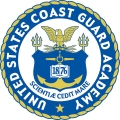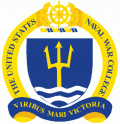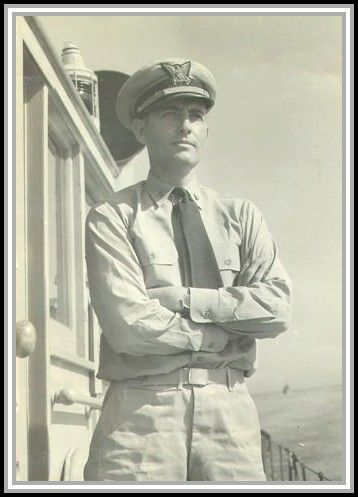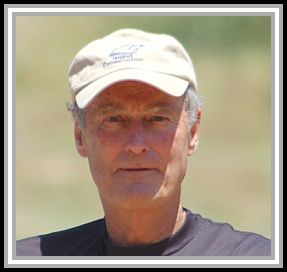LCDR O. C. Rohnke
SECTION 22.
SECTION 22. CONTENTS
Oscar Carl Rohnke, USCG, Lieutenant Commander
USS SAVAGE (DE-386)
Assumed command on 29 October, 1943 at Houston, Texas
Relieved of command on 11 May, 1944 at Navy Yard, New York
Lieutenant Commander O. C. Rohnke aboard the SAVAGE in 1944
Oscar Carl "Gus" Rohnke was born in Jersey City, New Jersey on 02 July, 1908.
He graduated from Lincoln High School in Jersey City, New Jersey.
Rohnke attended the Brooklyn Polytechnic Institute and the Newark Technical School and became a structural draftsman in private industry.
He entered the United States Coast Guard Academy in New London, Connecticut as a cadet on 01 August, 1929. He graduated and was commissioned as an Ensign on 16 May, 1932. He went on to attend the Naval War College, and graduated in 1951.
Rohnke's resume of his appointments in rank:
Lieutenant (jg) on 16 May, 1935
Lieutenant on 25 May, 1939
Lieutenant Commander on 26 June, 1942
Commander on 21 December, 1943
Captain on 12 November, 1952
Rear Admiral in 1961
He married Gladys May Kutcher on 28 November, 1935 in Eatontown, New Jersey. The couple had one son, Karl Edward.
After graduating from the Academy, his first assignment was serving on line duty of the New York Division until June 1934, aboard the Coast Guard cutter SENECA.
He was transferred to line duty aboard the Coast Guard cutter UNALGA at San Juan, Puerto Rico.
Performed line duties on Coast Guard cutter GALATEA (WPC-108) from December 1934 to December 1935.
Engineering duties aboard the USCGC PONTCHARTRAIN (WHEC-70) followed until January 1937.
The GALATEA and the PONTCHARTRAIN operated in the North Atlantic out of New York City.
Rohnke next worked as an inspector on the last construction stages and outfitting of the new 327 foot cutter GEORGE M. BIBB at the Navy Yard in Charleston, South Carolina. He was then assigned engineering duties aboard her after her commissioning on 10 March, 1937.
In February of 1939, Rohnke reported as Engineer Officer aboard the cutter SARANAC, which was based in Galveston, Texas.
April 1941 found Rohnke assigned as an instructor at the Coast Guard Training Station for Merchant Marine personnel at Fort Trumbell, New London, Connecticut. He also acted in an advisory capacity to the War Shipping Administration as it took over functions of training Merchant Marine officers and men from the Coast Guard in July 1942. By September 1942 he was assigned as Training Officer at the Coast Guard Training Station in St. Augustine, Florida.
After two months of indoctrination courses at the Submarine Chaser Training Center in Miami, Florida, Rohnke became the first Commanding Officer of the USS SAVAGE (DE-386) on 29 October, 1943.
In August of 1944, Rohnke was assigned as the Executive Officer of the troop transport ship USS ROBERT L. HOWZE (AP-134). He served in the Philippine Campaign.
In July 1945, Rohnke was placed in charge of a Radar Study Group attached to the Communications Division at Coast Guard Headquarters in Washington, D. C. The purpose of this group was to evaluate radar and racon, aids to navigation inventions born out of the war emergency, as to their practical usage to commercial shipping in peacetime. He also traveled extensively to lecture and give demonstrations before interested maritime groups and Coast Guard groups throughout various districts.
In June 1946 he became Chief, Shore Units Division of the Office of Operations at Coast Guard Headquarters in Washington, D. C.
September 1946 found Rohnke as the Commander of the Coast Guard cutter TAMPA (WPG-48) out of Miami, Florida.
January to December 1947 he commanded the cutter CAMPBELL. January to June 1948 commanded the USCGC SEBAGO (WHEC-42). Both ships were based in New York City.
From June 1948 until August 1950, Rohnke was assigned as Chief, Aids to Navigation Division of the Third Coast Guard District Office In New York City.In mid-1950, he was assigned as a student at the Naval War College in Newport, Rhode Island.
August 1951 - October 1952 commanded USCGC IROQUOIS (WHEC-43) out of Honolulu, Hawaii. Then served as Chief, Aids to Navigation at the Fourteenth Coast Guard District Office in Honolulu.
In July 1954, Rohnke joined the Coast Guard Polar icebreaker EASTWIND (WAGB-279) as her Commanding Officer. The EASTWIND immediately began annual summer operations with a Navy Task Force Group on a joint United States - Canadian resupply mission to Arctic weather stations and bases. A similar mission with EASTWIND was completed in September 1955.
Under Captain Rohnke's command, the EASTWIND (W-279), on 10 November, 1955 departed her homeport in Boston, Massachusetts to join Task Force 43, U. S. Naval Support Force, in conducting the first of many annual expeditions to follow tagged "Operation Deep Freeze I," which were to support scientific projects in Antarctica. This historic first expedition, headed by Admiral Richard Byrd, was organized to launch the United States' participation in the International Geophysical Year (IGY) scientific programs. EASTWIND'S works consisted of breaking paths through ice barriers for cargo ships, delivering manpower, supplies, food, fuel, and equipment vital to the establishment and existence of the scientific stations and bases. EASTWIND did not return until May 1956.
Rohnke then studied for three months at the Coast Guard Academy in New London. In October 1956 he was assigned to the Office of Merchant Marine Safety at Coast Guard Headquarters in Washington, D. C. as a traveling Marine Inspector.
In May 1958, he became officer-in-charge of the Coast Guard Marine Inspection Office in Long Beach, California, with collateral duties of Chief Merchant Marine Safety Division at the Eleventh Coast Guard District Office in Long Beach.
Captain Rhonke's WWII campaign medals and ribbons include the American Campaign, European-Africa-Middle Eastern Campaign; Asiatic-Pacific-Campaign; and the Philippine Liberation Ribbon with combat star.
Nomination of Captain Rohnke for Promotion to Rear Admiral, U. S. Senate, given by Commandant, USCG.
In April 1961, he was designated Chief of Staff of the Eleventh Coast Guard District.
"My first job as Admiral was command of the Second Coast Guard District (called The River District) which I held for about 1 year when I went to Washington where I took over the Office of Maritime Safety.
After three years of that I took command of the 5th Coast Guard District, with Headquarters in Portsmouth, Virginia.
I retired on 1 July, 1967.
Within a month I was offered a job with a subsidiary of U. S. Gypsum running their fleet with offices in Bermuda.
After four and a half years of that I reretired and became a Maritime Safety Consultant in Florida (Long Boat Key) and just faded into permanent retirement.
We next moved to Bradenton, Florida in 1971."
Rear Admiral Rohnke passed away on 10 November, 1996 in Sarasota, Florida at the age of 88. His ashes were interred, with those of Gladys Kutcher Rohnke; who preceded him in death on 24 January, 1992.
Rear Admiral Rohnke was afforded Final and Full Military Honors at Arlington National Cemetery
on 24 January, 1997.
[Photograph of LCDR Rohnke was most graciously donated by his son, Karl E. Rohnke. The webmaster of this site is extremely grateful to Karl for sharing this historical photo. It cannot be found elsewhere.]
[Karl graduated from Washington & Lee University (Lexington, VA) in 1960. After two drafted years in the U.S. Army, serving as a Medical Technologist, he used that medical training to secure a position as a Med. Tech. at a retirement community in California. This was followed by four years of teaching outdoor education in the Southern California area. Since that time, Karl has been an important "player" in the field of experiential/adventure education. He was a watch officer at Hurricane Island Outward Bound in 1967, and chief instructor at North Carolina Outward Bound until 1971. He left Outward Bound to become one of the founders of the Project Adventure program in Hamilton, MA, and worked there continuously until 1996. During his tenure at PA, he served as director and president of the company. Karl is also one of the founders of The High 5 Adventure Learning Center in Brattleboro, Vermont.
Karl has been the recipient of two A.E.E. (Association of Experiential Education) awards: The 1990 Stratton Practitioner's Award, and in 2000, he presented the Kurt Hahn Address at the national A.E.E. convention. Karl has written over 15 books that relate to the field of adventure education, including The Bottomless Bag Revival, Silver Bullets, Quicksilver, and Funn 'n Games. Karl's books are available HERE.
Karl says he's retired but continues to travel worldwide presenting clinics about the use of games and initiative problems as applied to various pedagogic applications. He currently lives in Galena, IL with his wife, Gloree.]
Karl E. "Skip" Rohnke
Class of 1951
Class of 1932
[Biographical information was written by RADM O. C. Rohnke in personal letters to Rollins W. Coakley,Y1c. Coakley served under Rohnke in WWII, and corresponded with him in later years. Biographical information in blue has been most graciously provided by William R. Bauer, PA, of Columbia, South Carolina. Bill is Karl's cousin, and a genealogist - this material is © copyrighted 1998 to William R. Bauer. Bill's notes were critical to the completion of RADM Rohnke's career history.]



